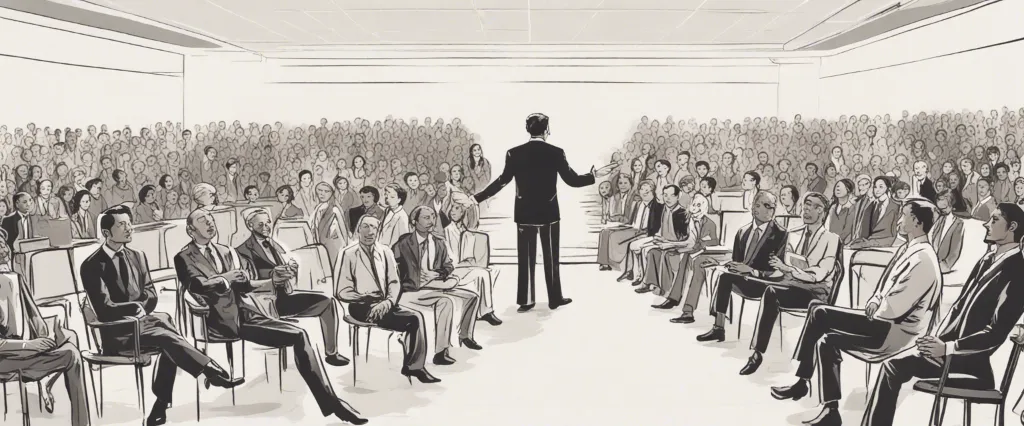In “Presenting to Win,” renowned presentation coach Jerry Weissman unveils the secrets to delivering compelling and persuasive presentations that capture the attention and engage the hearts and minds of your audience. With decades of experience in coaching top executives and TED speakers, Weissman offers a systematic approach to crafting and delivering remarkable presentations that not only inform but inspire action. His proven techniques and strategies have helped countless professionals master the art of presenting, making this book a must-read for anyone looking to become a master communicator. Jerry Weissman is a world-renowned guru in the field of professional presentations. With over 30 years of experience, he has coached executives at numerous prestigious firms including Cisco Systems, Intel, and Microsoft. Through his consulting firm, Weissman and Associates, he has assisted clients in preparing for some of the most critical presentations in their careers. Weissman is also an accomplished author, having written several bestselling books on presentation techniques.
Chapter 1: The Power of Presentations
In Chapter 1 of Presenting to Win by Jerry Weissman, the author emphasizes the significance of presentations in modern-day communication. He asserts that effective presentations have the power to influence, inspire, and persuade people, making them an invaluable skill in business and beyond. The chapter begins by highlighting the importance of capturing and maintaining an audience’s attention and interest from the very start of a presentation.
Weissman highlights the three primary elements that every successful presentation should possess: focus, flow, and empathy. Focus refers to the presenter’s ability to define a clear message and stick to it throughout the entire presentation. Flow is the seamless and logical progression of ideas that keeps the audience engaged and helps them understand and retain the information. Empathy involves understanding the audience’s needs, concerns, and desires, and tailoring the presentation to resonate with them.
The chapter introduces the “WIIFY” principle, which stands for “What’s In It For You.” This concept emphasizes the importance of understanding the audience’s perspective and addressing their needs and interests. By focusing on what the audience wants to gain from the presentation, presenters can effectively communicate their message and increase their chances of achieving their desired outcomes.
Weissman also introduces the concept of “The Conversation.” He argues that presentations should be viewed as dialogues rather than monologues, encouraging presenters to listen to their audience, involve them, and adapt their content accordingly. By creating a sense of dialogue, presenters can establish a connection with their audience, build trust, and increase the impact of their message.
Overall, Chapter 1 of “Presenting to Win” highlights the power and importance of presentations. It emphasizes the need for focus, flow, and empathy in delivering effective presentations, encourages presenters to understand their audience’s perspective, and introduces the concept of “The Conversation” as a way to establish a meaningful connection with the audience.
Chapter 2: Crafting a Compelling Story
In Chapter 2 of “Presenting to Win” by Jerry Weissman, titled “Crafting a Compelling Story,” the author emphasizes the importance of storytelling in creating persuasive presentations. Weissman argues that humans are inherently drawn to stories, and utilizing storytelling techniques can greatly enhance the impact and effectiveness of a presentation.
The chapter begins by discussing the power of the “what it is, what it isn’t” framework, which involves defining and differentiating a concept or product. By drawing clear contrasts and setting up expectations, presenters can engage their audience and create a compelling narrative. Weissman provides examples of how this framework has been successfully used in various industries.
Next, the author introduces the concept of the “quel, no sequel” approach, which involves identifying the current state of affairs (quel) and presenting a proposed solution or future state (no sequel). This technique allows presenters to emphasize the need for change and create a sense of urgency. Weissman provides practical advice on how to structure presentations using the “quel, no sequel” method, including avoiding overt criticism and employing visuals to support the narrative.
Furthermore, Weissman discusses the importance of a protagonist in storytelling, emphasizing that presenters should position their audience as the hero in the story. This concept involves understanding the needs, desires, and challenges of the audience and tailoring the presentation to address them effectively. By doing so, presenters can establish a connection with their audience and motivate them to action.
Lastly, the chapter underscores the significance of engaging emotions in presentations. Weissman introduces the “you, me, we” framework, which aims to create an emotional connection by aligning the presenter’s experiences and understanding with the audience’s needs. By sharing relatable stories and personal insights, presenters can elicit empathy and foster a sense of camaraderie, leading to enhanced persuasive power.
Overall, Chapter 2 of “Presenting to Win” emphasizes the value of storytelling in presentations and offers practical techniques and frameworks to craft compelling narratives that resonate with the audience.
Chapter 3: Developing a Clear Message
Chapter 3 of the book “Presenting to Win” by Jerry Weissman, titled “Developing a Clear Message,” focuses on the importance of crafting a concise and compelling message for effective communication and presentation. The chapter provides a step-by-step guide to help readers develop a clear message that resonates with their audience.
The chapter begins with the author emphasizing the role of a clear message as the foundation of any successful presentation. Weissman highlights that a clear message should be easily understood, memorable, and persuasive. He argues that a well-crafted message can greatly influence the audience’s perception and engagement.
Weissman then introduces the concept of the “emotional branding iron,” a metaphorical tool used to sear the essential message into the audience’s minds. He suggests that presenters should condense their message into a single, concise sentence that encapsulates the core idea they want to convey.
To develop this clear message, Weissman advises utilizing the “Audience Needs Pyramid,” a framework that categorizes the audience’s needs into three levels: Basic, Value, and Action. By understanding these needs, presenters can tailor their message to address them effectively and maximize audience engagement.
The chapter further delves into techniques for refining the message, such as using metaphors, analogies, and contrasts to make it more relatable and understandable. Weissman stresses the importance of using tangible and easily relatable examples to ensure the audience’s comprehension.
Lastly, he highlights the significance of rehearsal for delivering the message with impact and confidence. With extensive practice, presenters can internalize their message and deliver it naturally, enhancing their credibility and persuasiveness.
In summary, Chapter 3 of “Presenting to Win” focuses on developing a clear message that resonates with the audience. It emphasizes condensing the message into a concise sentence, understanding and addressing audience needs, utilizing relatable examples, and rehearsing effectively. By following the guidelines provided, readers can craft powerful messages that leave a lasting impact on their audience.
Chapter 4: Creating Engaging Visuals

Chapter 4 of the book “Presenting to Win” by Jerry Weissman focuses on the importance of creating engaging visuals in presentations. Weissman emphasizes that visuals play a significant role in supporting and enhancing the speaker’s message. In this chapter, he provides guidance on how to create impactful visuals that resonate with the audience.
Weissman starts by advising presenters to maximize the use of images and minimize text on their slides. He stresses that visuals should be attention-grabbing and convey a clear message, allowing the audience to grasp the information easily. He suggests using high-quality images, charts, and diagrams that are relevant to the content being discussed.
The author highlights the significance of storytelling through visuals. He explains that narratives are powerful tools for engaging the audience and making complex ideas more understandable. Weissman encourages presenters to use visuals that tell a story, guiding the audience through a logical flow of information.
Furthermore, Weissman provides tips on formatting visuals effectively. He advises presenters to use large fonts, bold colors, and contrast to ensure readability. The author explains the importance of consistent formatting throughout the presentation to maintain visual coherence.
Additionally, Weissman addresses the effective use of animation and multimedia in presentations. While these elements can enhance engagement, he emphasizes that they should be used sparingly and purposefully. Presenters should only incorporate animation or multimedia if they add value to the message and contribute to the overall objective of the presentation.
In conclusion, Chapter 4 of “Presenting to Win” emphasizes the importance of creating engaging visuals that support and enhance a presentation. Weissman’s guidance on using impactful images, storytelling techniques, effective formatting, and the appropriate use of animation and multimedia helps presenters deliver more captivating and persuasive presentations.
Chapter 5: Delivering with Confidence
In Chapter 5 of “Presenting to Win” by Jerry Weissman, titled “Delivering with Confidence,” the author emphasizes the importance of maintaining confidence while delivering a presentation. Weissman states that confidence is a vital component in successfully engaging an audience and conveying a message effectively.
The chapter starts by discussing the importance of rehearsal in building self-assurance. Weissman emphasizes that practice is not just about memorizing lines but also about internalizing the content to respond naturally and comfortably. He suggests conducting a “technical rehearsal” to familiarize oneself with the presentation equipment, software, and surroundings before the actual event, ensuring a smooth delivery.
Weissman also advises presenters to establish credibility by appearing confident and knowledgeable. He highlights the significance of nonverbal communication, such as posture, gestures, and eye contact, in reinforcing confidence. The author stresses the importance of maintaining a positive attitude and controlling nervousness to exude authenticity and credibility.
Furthermore, Weissman explores the concept of pacing and vocal variety. He advises presenters to vary their tone, inflection, and speed to maintain audience engagement and prevent monotony. He also emphasizes the need for effective pauses, allowing both the audience and speaker to absorb information and create moments of reflection.
Additionally, the author delves into the use of visual aids, cautioning against relying too heavily on them. Weissman suggests that presenters should internalize the content and use visual aids as supporting tools rather than relying on them as a crutch. By doing so, the presenter appears more confident and knowledgeable while allowing the audience to focus on the speaker’s message.
In summary, Chapter 5 of “Presenting to Win” highlights the significance of delivering a presentation with confidence. It emphasizes the importance of rehearsal, nonverbal communication, vocal variety, and effective usage of visual aids to engage the audience and deliver a successful presentation.
Chapter 6: Handling Q&A Sessions
Chapter 6: Handling Q&A Sessions of the book “Presenting to Win” by Jerry Weissman focuses on providing valuable insights and techniques for effectively managing and responding to questions during a presentation.
Weissman begins by emphasizing the importance of preparing for possible questions in advance. He advises researching the audience, anticipating their concerns, and anticipating the questions they are likely to ask. By doing so, presenters can strategize and develop appropriate responses. Additionally, Weissman highlights the significance of active listening during Q&A sessions, urging presenters to pay close attention to fully understand each question before responding.
The author offers various techniques to handle different types of questions. For hostile or aggressive questions, he suggests a strategic approach of acknowledging the questioner’s perspective, reframing the question in a more positive light, and answering in a calm and composed manner. For questions that are difficult to address directly or require more time, Weissman recommends deferring the response by promising to follow up or directing the question to another expert in the team.
Furthermore, Weissman advises presenters to be transparent and authentic during Q&A sessions. He encourages presenters to honestly admit if they don’t know the answer to a question, offering to look into it further and get back to the questioner later. This demonstrates honesty, credibility, and a commitment to delivering accurate information.
Overall, the chapter emphasizes the importance of being well-prepared, actively listening, and managing questions with composure and authenticity. By implementing the strategies and techniques discussed in this chapter, presenters can navigate Q&A sessions effectively and engage with their audience in a confident and professional manner.
Chapter 7: Engaging and Influencing the Audience
Chapter 7 of “Presenting to Win” by Jerry Weissman is titled “Engaging and Influencing the Audience.” This chapter focuses on methods and strategies to captivate and persuade the audience during a presentation.
Weissman emphasizes the importance of gaining the audience’s attention from the very start of a presentation. He advises presenters to begin with a powerful and thought-provoking statement or question to immediately engage the audience. By doing so, presenters can establish a connection and generate interest. Additionally, Weissman suggests incorporating engaging visuals such as images, video clips, or props, which help to enhance understanding and create a compelling narrative.
The chapter explains the significance of storytelling in presentations, noting that stories have a greater impact on the audience than facts and figures alone. Weissman provides a framework for crafting effective stories, encouraging presenters to use relatable characters, conflict, resolutions, and lessons to create a compelling narrative that emotionally connects with the audience. By sharing relatable stories, presenters can effectively convey their message and influence the audience’s opinions and decisions.
Furthermore, Weissman introduces the concept of anticipatory storytelling, where presenters address potential objections or concerns before the audience raises them. By preemptively addressing these concerns and offering compelling counterarguments, presenters can build credibility, establish trust, and mitigate resistance from the audience.
To effectively engage and influence the audience, Weissman also stresses the importance of interactivity during a presentation. He advises presenters to actively involve the audience through questions, polls, or group activities, fostering a sense of participation and investment. By doing so, presenters can enhance audience engagement, understanding, and retention.
Overall, Chapter 7 of “Presenting to Win” discusses various strategies and techniques for engaging and influencing the audience. Through powerful openings, storytelling, anticipatory storytelling, and interactivity, presenters can capture the audience’s attention, hold their interest, and effectively persuade them to take the desired actions.

Chapter 8: Overcoming Obstacles and Winning the Deal
Chapter 8 of “Presenting to Win” by Jerry Weissman, titled “Overcoming Obstacles and Winning the Deal,” focuses on strategies for navigating and addressing obstacles that may arise during sales presentations. Weissman acknowledges that obstacles are a natural part of the sales process and emphasizes the importance of overcoming them to secure successful deals.
The chapter begins by highlighting the significance of comprehensive preparation. Weissman emphasizes the need to anticipate potential obstacles by conducting thorough research on the audience, competitors, and industry trends. Armed with this knowledge, presenters can address objections proactively, demonstrating their expertise and credibility.
Weissman introduces a six-step framework called AGREE, which stands for Acknowledge, Get the Facts, Return to the Main Message, Explain, Execute, and Ask for Approval. This framework provides a systematic approach for effectively handling obstacles during presentations.
The first step, Acknowledge, involves acknowledging the objection rather than dismissing or arguing against it. It is crucial to understand the perspective of the audience and validate their concerns genuinely. Getting the Facts entails gathering more information about the objection to better address it. Return to the Main Message reminds presenters to refocus the discussion on the primary message and goals of the presentation.
Next, Explain involves providing a clear and concise response to the objection by using supporting evidence, data, and relevant examples. The Execute step encourages presenters to illustrate how their proposed solutions can overcome the obstacles, demonstrating feasibility and effectiveness.
Lastly, the presenter should Ask for Approval, seeking confirmation from the audience that the objection has been resolved satisfactorily. This step ensures that any remaining concerns are fully addressed and allows the presenter to move forward with a strengthened argument.
Through the AGREE framework, Weissman provides a methodology for presenters to confront obstacles head-on and win deals. The chapter emphasizes the importance of preparation, empathy, and flexibility in overcoming objections successfully and ultimately securing the desired outcome.
After Reading
In conclusion, Jerry Weissman’s book, “Presenting to Win,” offers valuable insights and practical techniques for delivering impactful presentations. The author emphasizes the importance of capturing and maintaining the audience’s attention by storytelling, creating compelling visuals, and using effective body language. Weissman provides comprehensive guidance on structuring presentations, from crafting clear messages to delivering them in a persuasive and engaging manner. With numerous real-life examples and step-by-step strategies, “Presenting to Win” equips readers with the tools necessary to confidently and successfully communicate their ideas, leaving a lasting impact on their audience.
1. “Slide:ology: The Art and Science of Creating Great Presentations” by Nancy Duarte – This book provides valuable insights into creating visually stunning and compelling presentations. It offers practical tips on slide design, storytelling techniques, and how to craft clear and persuasive messages.
2. The Presentation Secrets of Steve Jobs: How to Be Insanely Great in Front of Any Audience” by Carmine Gallo – Drawing inspiration from the legendary Apple CEO, this book provides practical advice on delivering memorable and impactful presentations. It emphasizes the importance of storytelling, simplicity, and passion to captivate an audience.
3. Talk Like TED: The 9 Public-Speaking Secrets of the World’s Top Minds” by Carmine Gallo – In this book, Gallo unveils the strategies and techniques used by the most successful TED speakers. From crafting a captivating narrative to delivering with authenticity and passion, this book offers invaluable guidance for anyone looking to enhance their presentation skills.
4. Made to Stick: Why Some Ideas Survive and Others Die” by Chip Heath and Dan Heath – Focusing on the principles of successful communication, this book explores what makes some ideas stick in people’s minds while others fade away. It offers practical advice on creating memorable messages that resonate with an audience, using real-world examples and insightful storytelling.
5. “Resonate: Present Visual Stories that Transform Audiences” by Nancy Duarte – Building upon her earlier book “Slide:ology,” Duarte delves deeper into the art of visual storytelling. This book teaches readers how to create presentations that touch the audience on an emotional level, fostering a deeper connection and understanding. It includes case studies and practical tools to make your presentations resonate with impact.




